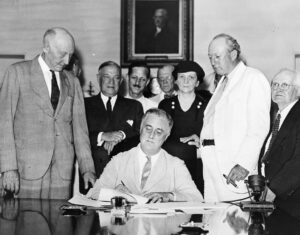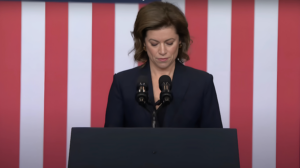How religion can help: resources that faith communities offer for the restoration of the common good.
by Charles Hoffacker
Robert B. Reich teaches Public Policy at the University of California, served in three presidential administrations, and is the author of fifteen books and a vast number of articles. The Frances Perkins Center is honored to count him as a member of our Advisory Council. Second only to Frances Perkins, he is my favorite United States Secretary of Labor!
Reich’s newest book, The Common Good explores the concept of the common good in American society, how it has been eclipsed in recent decades, and ways it can be restored as an essential element of our national life. He defines the common good as consisting of “our shared values about what we owe one another as citizens who are bound together in the same society–the norms we voluntarily abide by, and the ideals we seek to achieve.” The common good, as Reich presents it, is essentially the same as the public good advocated in the Frances Perkins Homestead Campaign motto, Seeking the Public Good.
Reich recalls a trio of structural breakdowns responsible for the sad state of the common good in contemporary America. One is the “whatever it takes to win politics” exemplified by Nixon’s Watergate and Robert Bork’s hearing. Another is the “whatever it takes to maximize profits” business model exemplified by Michael Miliken and Jack Welch. These distortions combine to produce the third breakdown: the “whatever it takes to rig the economy” machinations exemplified by Lewis Powell’s memo, Tony Coelho’s bargain, and Wall Street’s bailout.
Four chapters offer ways by which the common good can be restored.
These include a return to leadership as trusteeship, a realignment of how shame and honor apply in our society, the propagation and protection of public truth, and vigorous civic education for all ages. Reich is convinced that the common good can be restored “by striving for it and showing others it’s worth the effort” although bringing it back may take fifty years or more.
This lucid book should be read by anyone already working to restore the common good in America, as well as by people struggling to see how such a restoration is possible. A topic Reich only hints at is how faith communities can provide distinctive resources for this struggle.
I believe that faith communities of many traditions can and do bring to the public square resources for the restoration of the common good. Much of the American political landscape is toxic, including some of its most visible features. The same holds true of the American religious landscape. However, vast tracts of both remain healthy and can be drawn upon for this societal task that requires action by a rich mosaic of persons, groups, and institutions.
The religious resources I have in mind in some cases reside in local assemblies such as congregations, mosques, parishes, and synagogues. In other cases, they reside in specialized organizations or the regional and national structures of denominations. While a faith perspective
is helpful in understanding these resources in depth, each of them is manifest in ways that a sociological perspective can recognize and appreciate as well. The resources named here are not meant as an exhaustive list. Others could be identified.
Local assemblies are experienced in pursuing the common good on a regular basis and in diverse ways.
Congregations, mosques, parishes, and synagogues function day by day, week by week, year by year in ways that promote the common good of both their members and the larger society. Even local assemblies well supplied with full-time clergy and other staff depend extensively on
the willingness of members to address tasks large and small that are necessary for the assembly to survive and fulfill its mission in its neighborhood and beyond. Members who are not so active witness what active members do and as a result they may in time become more engaged. A local assembly is inevitably an ongoing exercise in cooperation, one that persists for decades and even centuries.
The ministries of local assemblies often focus on ordinary human needs
that everyone understands. For example, countless local assemblies offer meals for free or distribute food for free to people who would otherwise go hungry. Refugees receive help in finding and furnishing apartments and with numerous other issues that arise when a family relocates to a new community. Such everyday assistance belongs to the common good.
More so than many institutions in our society, faith communities are adept at recognizing indivisible goods and assessing moral concerns.
Divisible goods resemble pies: if you receive a bigger piece, then I receive a smaller one. Faith communities deal with divisible goods, especially in developing their annual budgets! But they point insistently to indivisible goods such as faith, mercy, justice, and forgiveness. Everyone is invited to share in these goods, and the more people who do so, the better. A faith community makes decisions about divisible goods based on its experience of indivisible goods and believes that any human society promoting the common good does something similar.
Thus, like other groups in society, faith communities face a myriad of practical questions in their organizational life. But they cannot remain true to themselves without respecting the spiritual and ethical aspects of the practical issues they confront.
In August 2017, people of various faiths assessed moral concerns that arose from an impending white racist rally set for Charlottesville, Virginia and decided to travel there to witness against hate. The Nazis and KKK members gathered downtown found themselves confronted by an opposition that included many religious leaders recognizable by their vestments.
Faith communities function as ongoing communities of moral discourse.
Faith communities on every level (local, regional, national, international) must function as communities of moral discourse concerned for both themselves and the larger human and planetary communities to which they belong. Whether seen as traditional, moderate, or progressive, faith communities face the continuing task of reflecting on their beliefs and applying them to the changing circumstances and questions of life.
Within faith communities, public reflection and application of this sort is often delegated to persons and groups, including representative bodies, that do this work in ways that are thoughtful, thorough, articulate, and even courageous. This process may produce stances and statements that enlighten people inside and outside of the particular faith community. Major denominations in several religions follow forms of governance that allow them to speak a timely word on societal issues as well as address internal business.
A widely known example of this activity is Pope Francis’ encyclical on the environment, which has been welcomed by many people both inside and outside the Catholic Church. This document is the latest in a series of papal social encyclicals that have appeared at intervals for more than a century and continue to provide useful insights on practical economic issues.
The governing councils of faith communities are generally free from the extreme forms of partisanship that now afflict the United States Congress and many state legislatures. Money does not influence voices or votes in religious assemblies in anything like the way this can happen in civil politics. Participants in religious assemblies often succeed in seeing even the most divisive issues in the light of higher purposes than ordinary winning and losing. A sense of the common good is tangible.
Many faith communities are grounded in long-established traditions and participate in worldwide spiritual fellowships, both of which relativize the current claims and perspectives of American society.
The majority of American faith communities are manifestations of religious traditions that pre-date the establishment of our republic. They are communities of memory that have not forgotten their experiences in other ages, other societies. In some cases, they have seen a long list of empires come and go.
In addition, American faith communities often vigorously participate in global fellowships with co-religionists living in distant places and in very different societies. These global fellowships are not simply concepts. They involve more than sharing a common past. They include interchanges of personnel, resources, and viewpoints that transform both parties. For example, American Christians no longer understand themselves as simply giving and people elsewhere simply receiving. Mission now flows in all directions and results in mutual enrichment.
Immigrants have revitalized countless American faith communities that otherwise would have closed their doors.
Americans active in faith communities frequently discover that their tradition is shaped in distinctive ways by local culture wherever the tradition is planted. The perspectives of their co-religionists elsewhere offer a wisdom that they need and that leads them to a more realistic assessment of their own situation as believers and citizens here in America.
Communities of faith are in general local, widespread, and popular.
As such, they help restore the common good, working together with diverse partners, including but not limited to other faith communities.
Our rural areas, small towns, suburbs, and cities are full of local religious assemblies. They anchor their neighborhoods, and if they close, the pain may be felt by more than their congregants alone. Some faith traditions are represented throughout the nation, others are more regional in character. Some traditions are highly visible, while others function in less apparent ways. Taken collectively, faith communities in all their diversity make up a big part of the American landscape. Despite some recent decline, participation in faith communities remains a very popular activity among Americans. A local decline in membership may even be accompanied by increased activity and financial giving by members who remain.
The effectiveness of work for the common good tends to increase when
multiple groups participate together. Thus believers and atheists work side by side to feed the hungry. The partners in an emergency housing coalition include a law firm as well as congregations and neighborhood
organizations. The route of an urban walk against gun violence includes
visits to a synagogue, a mosque, and a church.
Conclusion
People concerned with the restoration of the common good in America need to be aware of the distinctive resources that faith communities bring to this task. Members of faith communities should recognize these resources also, together with the opportunities they have to take part in the rebuilding of our damaged society.
I do not endorse the civil establishment of any religion or religions,
whether historic traditions, new faiths, or civil religion. The lack of such an establishment has contributed to the flourishing of religions in the United States. American religion does not own the public square, nor should it. But this country’s faith traditions, in their remarkable diversity, deserve to have voices in the public square. In our time, they can assist in the development of a more gracious and just social order through a widespread renewal of the common good.
The Rev. Charles Hoffacker is a priest of the Episcopal Church and serves on the board of directors of the Frances Perkins Center.


